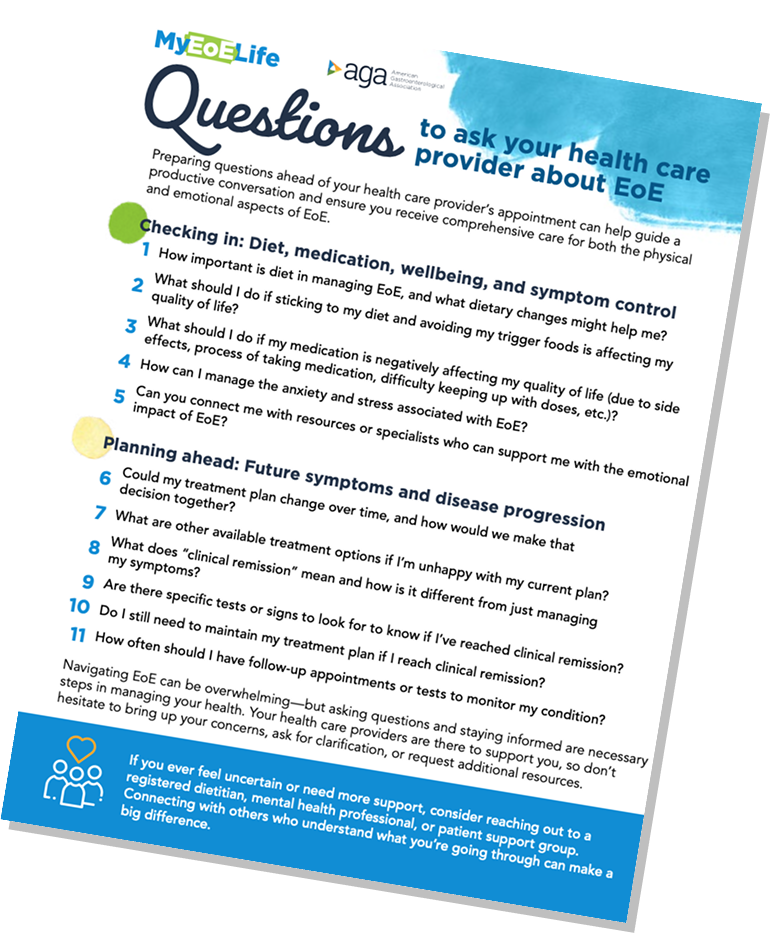Taking care of
body
and
mind

When EoE affects your whole self
Unfortunately, EoE doesn’t always stop at physical symptoms. It can affect how you feel about food, how you show up in relationships, and how you move through the world. Maybe you’ve canceled plans because you didn’t feel safe eating out. Maybe you’ve felt isolated or struggled to explain what’s happening to people who just don’t understand.
This section is here to help with caring for the whole you—your body, your mind, and everything in between—with tools you can use and support that make space for all of it.
Beyond just physical: Let’s talk about EoE and mental health
EoE affects more than your body. It can impact how you feel day to day, physically, emotionally, and socially. Maybe you’ve:
Worried about food impactions.
Felt frustrated by flare-ups.
Missed out on plans because of fatigue.
Skipped meals or avoided eating out because of anxiety.
Pulled back from plans or people who don’t “get it.”
That stress is real. And so is the impact it can have on your mental health. Here’s what can help:
Open conversations with friends, family, or partners
Simple coping tools like journaling, mindfulness, or setting boundaries around events
Support groups that connect you with people who understand
Talking to a therapist or mental health professional
You don’t have to have it all figured out. But you do deserve support that goes beyond the physical. Remember, you’re not alone.
Eating well with EoE: Diet and nutrition
Food is a big part of living with EoE. It’s how many people first notice symptoms, and often, it’s where the hardest adjustments begin. Many people with EoE use dietary therapy to manage their condition. This means avoiding certain foods. Reading every label. Figuring out what’s safe, and what’s not, in a world that isn’t built with your needs in mind.
It’s not easy. But with the right support and a little planning, it gets more manageable and less overwhelming.
Here’s what to know:
Common trigger foods include dairy, wheat, eggs, soy, nuts, and seafood.
Alternative foods and recipes can help you build a routine that works (and that you actually enjoy).
Elimination diets can help identify what’s causing symptoms, especially when guided by a registered dietitian or health care provider who knows EoE. The goal is not to stay on restrictive diets forever, but rather to figure out which foods are causing problems and come up with a plan.
Eating out is possible. It just takes prep. Look up menus ahead of time, call restaurants, ask questions, and don’t hesitate to bring something safe.
You don’t have to face this alone. If your anxiety or fear about eating is leading to food avoidance, seek out help from your health care provider or a mental health professional. Additionally, if you have questions about managing your diet with EoE or eating healthy, coordinate with your registered dietitian.
There’s no one right way to eat with EoE. But there is a way that works for you, and you don’t have to figure it out alone.
Looking at the bigger picture
Understanding inflammation and related conditions
EoE isn’t always the whole story. It can be part of a bigger pattern that has to do with how your immune system reacts, how inflammation shows up in your body, and how that can connect to other conditions you may be dealing with, too.
So, what’s really happening?
EoE is caused by inflammation. Your body thinks certain foods or allergens are a threat, and it responds by sending immune cells, called eosinophils, to the esophagus. When this immune response becomes chronic, it can lead to symptoms like pain, swelling, and difficulty swallowing. And for many people, that same immune response shows up in other ways.
Understanding inflammation and related conditions
You might hear your health care provider call these “comorbidities,” but think of them as overlapping pieces of a bigger picture. If you live with more than one of these, you’re not alone:
Asthma: Inflammation in the lungs instead of the esophagus, but often triggered by the same things, like pollen, dust, or certain foods.
GERD (acid reflux): Another condition that affects the esophagus, sometimes alongside EoE. The two can feel similar—and can be confused for each other—but need different kinds of care.
Allergic conditions: Eczema, hay fever, food allergies. These are all part of the same pattern: an immune system that’s reacting more than it should.
Why it matters
Understanding the connection between these conditions helps you take better care of yourself. For example:
- Treating seasonal allergies might make your EoE symptoms easier to manage.
- Keeping asthma under control could help reduce inflammation overall.
- Talking to your health care provider about everything you’re experiencing from head to toe can help them see the full picture and recommend care that works across conditions.
This is why it’s important to have a team: a GI provider, an allergist, a registered dietitian, maybe a therapist, too. Your primary care provider can be a good resource to connect you with the specialists you need. The goal isn’t just to react to symptoms, but to understand what’s causing them and how they fit together.
Questions
to ask your health care provider
Your health care provider isn’t just there to treat your esophagus. They’re there to help you feel better, including what’s going on emotionally. If you’ve been skipping meals because you’re anxious about symptoms, avoiding plans, or just feeling worn down by the daily effort of managing EoE, it’s worth bringing it up.
To make the most of your next visit, we’ve created a resource with questions you can ask about mental health, nutrition, medication, and your overall care plan. Whether you’re starting a new treatment or checking in on how you’re doing, this guide can help you open up the conversation.









